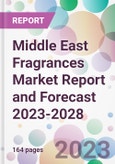Fragrances are complex compounds of natural or synthetic substances, used to impart a pleasant aroma to various products, including perfumes, soaps, cosmetics, and detergents. They play an essential role in enhancing mood, evoking memories, and expressing individuality. Beyond their aesthetic appeal, fragrances also serve functional roles such as masking unpleasant odours in various industrial applications.
The escalating consumer preference for high-quality fragrances is a significant driver of the Middle East fragrances market growth. With the rising awareness of the impact of scent on personal image and well-being, there has been a significant shift towards premium fragrance products. Additionally, the increasing disposable income in the Middle East and the region's historic fondness for strong, long-lasting perfumes have further contributed to the growing popularity of fragrances.
The widening applications of fragrances across various sectors also play a pivotal role in boosting the Middle East fragrances market expansion. In the cosmetic and personal care industry, fragrances are critical components used to enhance the sensory appeal of products. The household care industry utilises fragrances to impart a fresh and clean scent to its products. Furthermore, the burgeoning trend of aromatherapy has brought fragrances into the health and wellness space, where they are used for their therapeutic effects.
Moreover, the demand for natural and organic fragrance products has risen, leading to increased focus on essential oils and other plant-based scents in fragrance formulation. With the surge in consumer consciousness regarding product safety and the impact on the environment, fragrances derived from natural sources have gained significant traction, thereby enhancing the Middle East fragrances market growth.
Lastly, the growing trend of personalisation in fragrances, where consumers can create a signature scent that reflects their personality, has also led to Middle East fragrances market expansion. Niche perfume houses offering customised fragrance experiences are seeing a positive response from consumers seeking uniqueness and exclusivity.
Market Segmentation
The market can be divided based on form, demographics, sales channel, and country.Market Breakup by Form
- Perfume
- Deodorant
- Cologne
- Scent
- Body Mist
- Aftershave
- Roll-On
- Custom Made
- Others
Market Breakup by Demographics
- Men
- Women
- Unisex
Market Breakup by Sales Channel
- Online
- Offline
Market Breakup by Country
- Saudi Arabia
- United Arab Emirates
- Kuwait
- Iraq
- Others
Competitive Landscape
The report looks into the market shares, plant turnarounds, capacities, investments, and acquisitions and mergers, among other major developments, of the Middle East fragrances companies.Some of the major key players explored in the report are as follows:
- Ajmal Perfume
- Guccio Gucci S.p.A.
- LVMH Moët Hennessy
- AL Haramain Perfumes LLC
- Giorgio Armani S.p.A
- Abdul Samad Al Qurashi Company
- The Fragrance Kitchen
- Calvin Klein, Inc.
- Yas The Royal Name of Perfumes
- ODICT
- HB USA Holdings, Inc. (Kayali)
- Others
About the Analyst
Acquire unparalleled access to critical industry insights with our comprehensive market research reports, meticulously prepared by a team of seasoned experts. These reports are designed to equip decision-makers with an in-depth understanding of prevailing market trends, competitive landscapes, and growth opportunities.These high-quality, data-driven analyses provide the essential framework for organisations seeking to make informed and strategic decisions in an increasingly complex and rapidly evolving business environment. By investing in our market research reports, you can ensure your organisation remains agile, proactive, and poised for success in today's competitive market.
Don't miss the opportunity to elevate your business intelligence and fortify your strategic planning. Secure your organisation's future success by acquiring one of these reports today.
The analyst always strives to provide you with the latest information. The numbers in the article are only indicative and may be different from the actual report.
Table of Contents
Companies Mentioned
- Ajmal Perfume
- Guccio Gucci S.p.A.
- LVMH Moët Hennessy
- AL Haramain Perfumes LLC
- Giorgio Armani S.p.A
- Abdul Samad Al Qurashi Company
- The Fragrance Kitchen
- Calvin Klein Inc.
- Yas The Royal Name of Perfumes
- ODICT
- HB USA Holdings
Methodology

LOADING...
Table Information
| Report Attribute | Details |
|---|---|
| No. of Pages | 164 |
| Published | October 2023 |
| Forecast Period | 2023 - 2028 |
| Estimated Market Value ( USD | $ 2.85 Billion |
| Forecasted Market Value ( USD | $ 4 Billion |
| Compound Annual Growth Rate | 7.0% |
| Regions Covered | Middle East |
| No. of Companies Mentioned | 11 |








